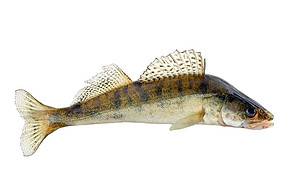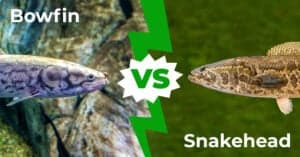The bowfin, also known as Amia calva, is a freshwater fish species native to North America. It is also commonly referred to as the mudfish, dogfish, and griddle. Bowfins can be found in slow-moving, shallow waters such as swamps, marshes, and backwaters of rivers, as well as in larger bodies of water like lakes and reservoirs. Although they generally aren’t considered very tasty unless knowledgeably prepared, they are a popular game fish because they respond to a variety of lures and baits and put up a hard, challenging fight. They usually weigh anywhere from 2-8 pounds, but the largest one ever caught was MUCH bigger. And the record catch in Florida comes close to that world record. Read on to find out more about the bowfin and the largest specimen ever caught in the state.
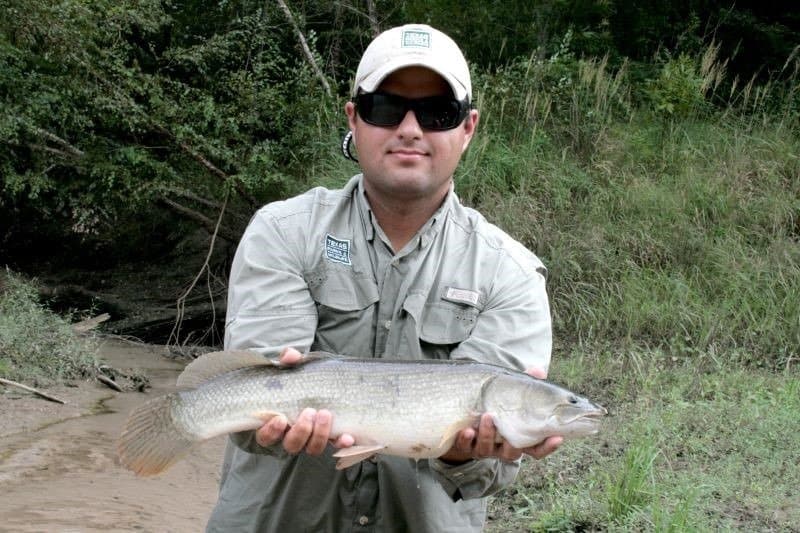
Bowfins are popular with anglers because they put up a hard fight.
©Clinton & Charles Robertson from RAF Lakenheath, UK & San Marcos, TX, USA & UK / CC BY 2.0 – License
Bowfin Description
Bowfins have long bodies sheathed in dark, splotchy scales. Their color is two-toned, with brown or olive on the top and lighter white or off-white on the bottom of their bodies. This helps camouflage them by making them harder to see from above, against the background of a muddy river bottom, or from below, against the bright sky reflected through the water. They have rounded tail fins and one long dorsal fin running along their backs. Their mouths are small but full of sharp teeth.
Bowfins are opportunistic predators, feeding on a variety of prey, including fish, crayfish, insects, and amphibians. They are also capable of consuming prey that is nearly their own size. On the other hand, remarkably, they have been demonstrated to go as long as 20 months without eating! They are primarily active at dawn and dusk but can be active throughout the day and night. Bowfins live a long time, reportedly up to 33 years!

Bowfins have mouths full of sharp teeth.
©IrinaK/Shutterstock.com
Bowfin Habitat
Bowfins can be found in the Mississippi River and in streams and rivers on the Gulf and Atlantic coasts as far north as Ontario and Quebec. From the late 1800s to the 1980s, they were intentionally introduced to ponds, lakes, and rivers in the United States, where they were not indigenous. As voracious predators, they have disturbed the ecological balance in many of these areas.
They like areas with dense vegetation, such as submerged logs and weeds, which provide cover for them to ambush prey. These fish don’t mind water conditions that would kill other species, such as muddy, stagnant water with low oxygen levels. They can survive these conditions by burrowing into the substrate and by supplementing their oxygen by breathing air with the aid of a specialized swim bladder adapted to that purpose. It works so well. They can even use it to leave the water and wiggle on land for short distances. This helps them move from one shallow puddle or pond to another. Scientists point to this kind of adaption to suggest how fish may have evolved into air-breathing land animals. In fact, bowfins are sometimes called “living fossils” because so many of their features have changed very little from their prehistoric ancestors.

Bowfins like water with submerged logs and other vegetation that provides them with hiding places from which to ambush their prey.
©iStock.com/undefined undefined
Record-Breaking Bowfins
So now that you know a little about bowfins, let’s get to those records. Remember that they grow only to 2-8 pounds normally. So, get this: the largest bowfin ever caught in Florida weighed 19 lbs! This state-record fish was caught by Jim Brown in Lake Kissimmee in November 1984.
That catch, glorious as it was, didn’t quite make the world record, which was set by Robert L. Harmon on January 29, 1980, in South Carolina. He reeled in a bowfin weighing a whopping 21 lbs. 8 oz!
Where is Lake Kissimmee Located on a Map?
Lake Kissimmee is a stunning natural wonder situated in the heart of Florida. If you are looking for directions to this beautiful lake, it can be found on any detailed map of Central Florida. To be more specific, Lake Kissimmee is located approximately 15 miles east of Lake Wales and about 50 miles southeast of Orlando.
To reach Lake Kissimmee by car, take State Road 60 from Vero Beach or Tampa and turn south onto County Road 630 at Yeehaw Junction. From there, follow the signs to the park entrance.
Once you arrive at Lake Kissimmee State Park, an array of outdoor recreational activities awaits you! From fishing and boating to hiking and camping, visitors have endless opportunities to explore this pristine natural habitat. So pack your bags and prepare for an unforgettable adventure in one of Florida’s most awe-inspiring locations – Lake Kissimmee!
Bowfin Conservation Status
The bowfin is listed as a species of least concern by the International Union for Conservation of Nature (IUCN). Even though they are not an endangered species in the world overall, in local areas they may be threatened by overfishing, loss of habitat, or water pollution. In different areas, there may be restrictions in place to preserve the number of bowfins for sport fishing and a healthy ecological balance.
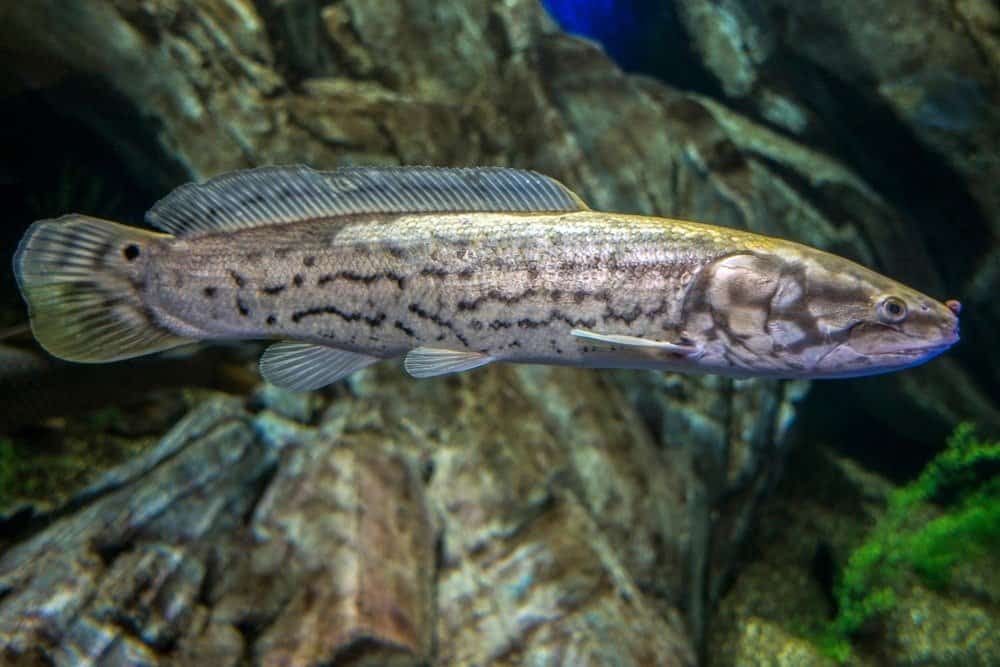
Bowfins are not an endangered species, but in some places their numbers are threatened locally by overfishing, pollution, or habitat destruction.
©Miroslav Halama/Shutterstock.com
Fishing for Bowfins
Bowfins can be caught using a variety of techniques, including:
- Bait Fishing: Live bait, such as minnows, crayfish, or worms are fished on a hook with a sinker to keep it near the bottom.
- Lure Fishing: Artificial lures can also be used. Spinnerbaits, crankbaits, and soft plastics imitate the natural prey of the bowfin, such as small fish or crayfish, and can be cast and retrieved or fished slowly along the bottom.
- Fly Fishing: Fly fishing for bowfin is a challenging and exciting experience, as they are known for their aggressive strikes and hard-fighting nature.
It’s recommended when bowfin fishing to use heavy tackle, as they are strong fish that can fight hard. When reeling in your catch, watch out for their sharp teeth. Use pliers to remove the hook and release the fish back into the water.
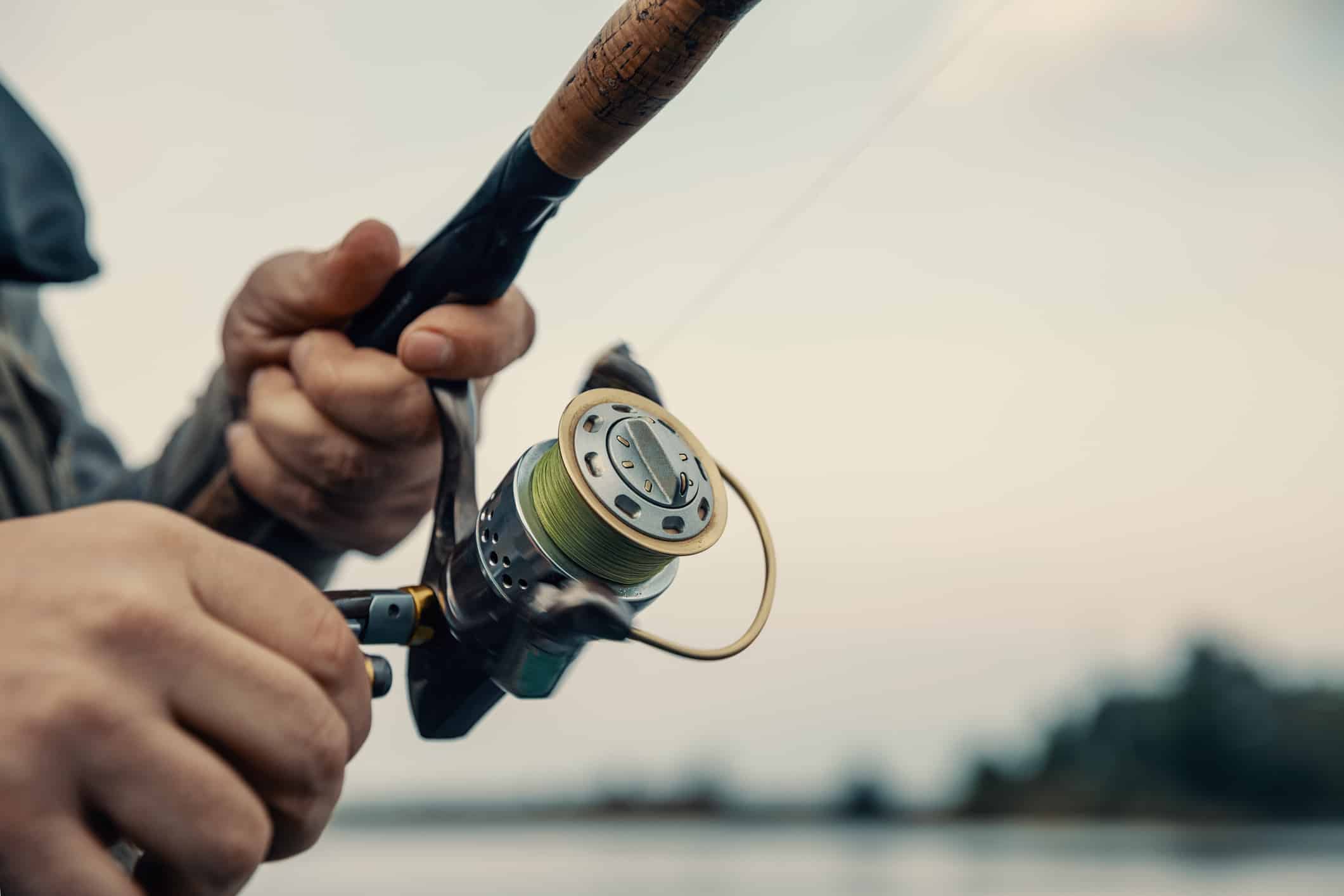
Heavy tackle is recommended for bowfin fishing, as they are strong fish that fight aggressively.
©iStock.com/smiltena
Where to Fish for Bowfins in Florida
Here are some of the best places to fish for bowfin in Florida:
- St. Johns River: This is the longest river in Florida with diverse fish species, including bowfins.
- Lake Okeechobee: The largest lake in Florida, covering over 730 square miles. Bowfins are just one of its many fish species.
- Kissimmee Chain of Lakes: This interconnected chain of lakes covers over 21,000 acres and is known for excellent bowfin fishing.
- Everglades National Park: The park has opportunities to fish for bowfins in both freshwater and brackish water habitats.
- Suwannee River: The river flows through remote areas of north-central Florida and offers scenic, peaceful fishing.
Be sure to get the necessary permits for fishing in Florida and check both state and local regulations for the specific area you’re wanting to fish. You can fish for bowfin year-round, but they are easiest to catch in the spring during the spawning season.
The photo featured at the top of this post is © Miroslav Halama/Shutterstock.com
FAQs (Frequently Asked Questions)
What is the largest bowfin ever caught in Florida?
The largest bowfin ever caught in Florida weighed 19 lbs! This state-record fish was caught by Jim Brown in Lake Kissimmee in November 1984.
What is the largest bowfin ever caught?
The largest bowfin ever caught was reeled in by Robert L. Harmon on January 29, 1980, in South Carolina. It weighed a whopping 21 lbs. 8 oz!
Do bowfins taste good?
They are generally not considered to be good-tasting fish, but knowledgeable cooks say they can be tasty if properly prepared.
What do bowfins eat?
Bowfins are opportunistic predators, feeding on a variety of prey including fish, crayfish, insects, and amphibians.
Are bowfins endangered?
Bowfins are not an endangered species. They are considered to be a species of least concern. However, in local areas they may be threatened by overfishing, loss of habitat, or water pollution.
What is the preferred habitat of bowfins?
Bowfins can be found in slow-moving, shallow waters such as swamps, marshes, and backwaters of rivers, as well as in larger bodies of water like lakes and reservoirs.
Where can I fish for bowfins in Florida?
- St. Johns River: This is the longest river in Florida with diverse fish species, including bowfin.
- Okeechobee Lake: The largest lake in Florida, covering over 730 square miles. Bowfin are just one of its many fish species.
- Kissimmee Chain of Lakes: This interconnected chain of lakes covers over 21,000 acres and is known for excellent bowfin fishing.
- Everglades National Park: The park has opportunities to fish for bowfin in both freshwater and brackish water habitats.
- Suwannee River: The river flows through remote areas of north-central Florida, for scenic, peaceful fishing.
Thank you for reading! Have some feedback for us? Contact the AZ Animals editorial team.



